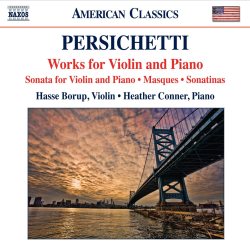| 
|
Vincent PERSICHETTI (1915-1987)
Sonata for Violin and Piano, Op. 15 (1941) [9:31]
Sonata for Solo Violin, Op. 10 (1940) [9:17]
Piano Sonatina No. 1, Op. 38 (1950) [3:48]
Piano Sonatina No. 2, Op. 45 (1950) [4:08]
Piano Sonatina No. 3, Op. 47 (1950) [3:11]
Piano Sonatina No. 4, Op. 63 (1954) [2:28]
Piano Sonatina No. 5, Op. 64 (1954) [2:04]
Piano Sonatina No. 6, Op. 65 (1954) [2:04]
Masques, Op. 99 (1965) [8:28]
Serenade No. 4 for Violin and Piano, Op. 28 (1945) [8:35]
Hasse Borup (violin); Heather Conner (piano).
rec. 7-10 October 2012, Libby Gardner Concert Hall, Salt Lake City, Utah, USA.
NAXOS 8.559725 [53:00]
American composer, teacher and pianist, Vincent Persichetti is sadly a much neglected composer of the twentieth century. His early style is marked by the influences of Hindemith, Stravinsky, Copland and Bartok, but his works are not mere pastiches of an earlier style. Whilst Persichetti said ‘listen to you, look at your score, and become you’ as he would ‘improvise pieces in your style’ (as his pupil Steve Reich commented); he was no lampooner. His compositions contain their own distinct flavour.
Born in Philadelphia in 1915, Persichetti began his musical life at age five, first studying piano, then organ, double bass, tuba, theory and composition. By the age of 11, he was paying for his own musical education and helping to support himself by performing professionally as an accompanist, radio pianist, orchestra member and church organist. At 16, he was appointed organist and choir director for the Arch Street Presbyterian Church in Philadelphia, a post he held for nearly twenty years.
Combining Persichetti’s versatility with a poetical musical mind — he composed a cycle of twenty interrelated songs to poems by Wallace Stevens entitled Harmonium — this CD replete with exciting premiere recordings offers a selection of his pieces for piano and violin. These are here played most perceptively.
Persichetti’s Sonata for Violin and Piano, Op. 15 was found in the archives of the New York Public Library by Borup, who then asked an undergraduate composition student at the University of Utah to transcribe the handwritten document into a music notation software programme. The result is the performance on this CD by Borup, accompanied by Conner. Written in 1941, a particularly formative time for Persichetti, this is an example of Persichetti’s use of twelve-tone technique. Commenting on his compositional style, Persichetti stated that: ‘Sound gestures come first, manipulation techniques later.’
Written in 1940, the Sonata for Solo Violin, Op. 10 combines Persichetti’s two self-attributed styles: ‘grace and ‘grittiness’. Beginning the second movement with tenderness and lyricism, Borup’s tone is earthy and contemplative, contrasting with the brisk and invigorating third movement. Borup manages skilfully to intertwine indulgent melodies with sharper and more intensely rhythmic passages.
Commenting on the Piano Sonatinas, Conner suggests that ‘these are delightful fleeting vignettes encompassing a wide array of emotions. They represent diverse pianistic styles ranging from the spirited toccata to charming plaintive melodies’. Using polytonality and pandiatonicism, Persichetti’s compositions contain abrupt rhythmic interjections whilst embracing the diverse strands of musical imagination. The Piano Sonatina No. 2, Op. 45 is an example of this swiftly changeable and unpredictable style and is played here with spontaneity and pep. Interestingly, in the second movement of the Piano Sonatina No. 3, Op. 47, there are echoes of Satie, but Persichetti’s voice is altogether more adventurous and fragmented.
The Masques, Op. 99 (1965) demonstrate Persichetti’s ability to combine heartfelt subtlety and savvy wit. Consisting of an admixture of didactic and aesthetic components the Masques evoke the styles of Persichetti’s influences. As Borup puts it, these are ‘well-crafted musical Haikus’. Much like Britten’s Six Metamorphoses after Ovid composed in 1951, each with a distinct character and flavour of its own, I imagine every listener picking out something different as his or her favourite.
Formally entitled Words Before Spring, Persichetti’s Serenade No. 4, Op. 28 are, according to the composer, ‘suites of ‘love’ pieces, usually of the night: small pieces of a certain lyric, under-the-window quality, that had precedence with Mozart and Brahms’. Nowhere is this spot-lit solitary quality more clearly expressed than in the third suite. Its closing note is held with intent and feeling. With virtuosic passages for the violin in the second and fourth suite and more introspective sections in the opening Pastorale and Interlude, Borup and Conner combine Persichetti’s compositions of frenzied thoughts tangled amidst a wondering mind. These are fine interpretations and well-crafted performances.
Lucy Jeffery
 |
 |
|
